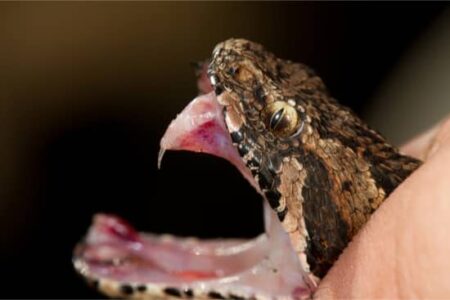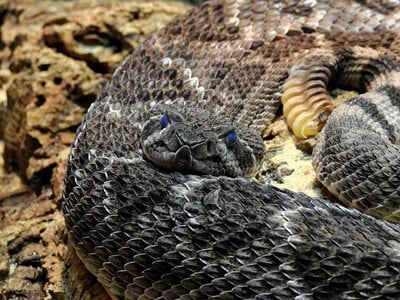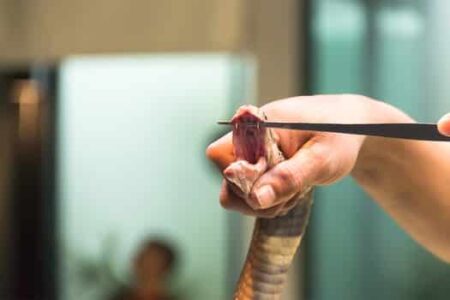Owning a venomous or ‘hot’ snake is dangerous. That’s why most people’s first instinct is to think about removing their fangs, so that they can’t bite you. But if you were to ask any experienced snake breeder or owner, practically none would recommend that you should remove a snake’s fangs.
You can make your snake a venomoid, but it’s a painful procedure and its fangs will grow back anyway. That’s why people remove their venom glands (venom ducts) instead.
The issue with defanging a snake is that it can cause significant pain. Even if you were to get a vet to perform the procedure, the snake would still be in great discomfort. A further issue is that it causes feeding problems.
Can You Take a Snake’s Fangs Out?
A snake that has been defanged, or otherwise rendered non-venomous, is called a venomoid. This can be achieved by removing the fangs or removing the venom glands.
Most owners who want to turn their snake into a venomoid do so by removing their venom glands, or the ducts that connect the venom glands to their fangs. The venom glands take longer to grow back than fangs, but even the venom glands will grow back eventually.
If you do own venomous snakes, then getting them defanged isn’t an alternative to learning how to handle them correctly. You still have to be sure that you know what you’re doing when you handle snakes.
That’s because they still aren’t safe. If you leave their venom glands alone, they will still contain venom, even if the snake can’t use it effectively.

How Are Snake Fangs Removed?
So, how do vets remove snake fangs? The American Society of Ichthyologists and Herpetologists (ASIH) details how the author tried to find a way to render venomous rattlesnakes harmless.
He started by removing both the fixed and reserve fangs, but found that this led to mouth rot more often than not, which almost always led to death.
He, therefore, stated that the ‘more elaborate operation’ of removing the snake’s venom glands was a better idea. The actual process of removing the fangs itself, though, is simple enough. Here’s how:
- To safely remove a snake’s fangs, it must be anesthetized. This stops the snake from biting you.
- The vet should test whether the snake is fully sedated by holding it behind the head and testing its bite reflex.
- Once the snake is adequately sedated, the teeth can be removed using clippers, pliers, or some other tool.
You will be hard-pressed to find any vet or breeder that will do this for you. That’s because removing snake fangs isn’t approved veterinary practice.
What they may do instead is remove the venom glands, which is much more effective at rendering venomous snakes harmless.
Do Snake Fangs Grow Back?
Snakes naturally lose their fangs and teeth in the wild all the time. Even though venom incapacitates prey, it will often try to fight back and can occasionally knock a snake’s fang or teeth out.
Some snakes hold onto prey after they bite it for the first time, and these snakes often break their fangs as they do. The prey is intent on not being eaten, so they’ll try their best to get away.
When they do lose fangs or teeth, they can grow them back quite quickly, depending on the species. Snakes often have spare fangs and teeth that will take the place of the lost one.
Alternatively, they can grow a new one back in place. That means if you’re intent on defanging a captive venomous snake, you’ll need to have it done repeatedly. The same applies to their venom glands.
How Long Do Snake Fangs Take to Grow Back?
In the South China Morning Post, it was claimed that most venomous snakes grow their fangs back after about 4 weeks.
Does Defanging a Snake Kill It?
Defanging a snake doesn’t kill it, but it does have some unpleasant side effects. The snake will have trouble digesting food.
A snake’s venom acts a bit like a stomach acid in that it starts breaking down the snake’s meal before they’ve even swallowed it. So, by removing the snake’s fangs, you make it more difficult for it to digest food.
Removing the fangs also increases the risk of infection. Snakes can experience a condition called ‘mouth rot’, which is exactly what it sounds like. This often occurs when a snake loses a tooth naturally, but it can also happen if you purposefully remove the fangs.
Essentially, the small wound left behind can become infected. Even worse, this infection can then pass into its bloodstream and cause sepsis, which can be fatal. So, yes, defanging a snake can kill a snake (albeit indirectly).
Should You Defang Snakes?
Fangs will grow back quickly (after about a month). So, you’d need to remove the snake’s fangs again and again.
Aside from that, there have been documented cases where a defanged snake has successfully bitten and envenomated someone. This is because the snake’s teeth had partially grown back.
There’s also the chance that the snake will puncture your skin using its other teeth, and deliver venom by getting some on the wound. So, defanging doesn’t entirely remove the chance of envenomation.

There are, however, many good reasons to defang a snake. If you keep a naturally venomous snake for educational purposes, defanging it will render it harmless and more easily used for those purposes.
That’s why zoos defang venomous snakes that are used to teach people about handling, or about the animals themselves. And while it isn’t an ideal solution, it’s also safer than not defanging them at all.
If you keep multiple venomous snakes together in an enclosure, defanging them will stop them from killing one another.
And if you keep venomous snakes for scientific research, defanging them can make them less dangerous while you’re studying them.
Can You Remove Snake Fangs at Home?
You should not attempt this at home. It’s highly likely that you will accidentally kill your snake. The main problem is that they will develop mouth rot as a result. However, there are other problems:
- You could use the wrong amount of sedative, which could kill the snake. Or you could fail to keep them sedated, resulting in a bite while you’re trying to get the work done.
- You could damage the lining of the snake’s mouth while you’re trying to remove the fangs.
- You could struggle to remove the fangs, damaging its mouth further as you try to pull them out.
It’ll be hard to find a vet that will perform this for you as it’s not a commonly accepted practice. Instead, a small number of breeders may remove your snake’s venom glands. Your best option is to find a breeder that sells venomoid snakes, and buy a venomous snake from them.

